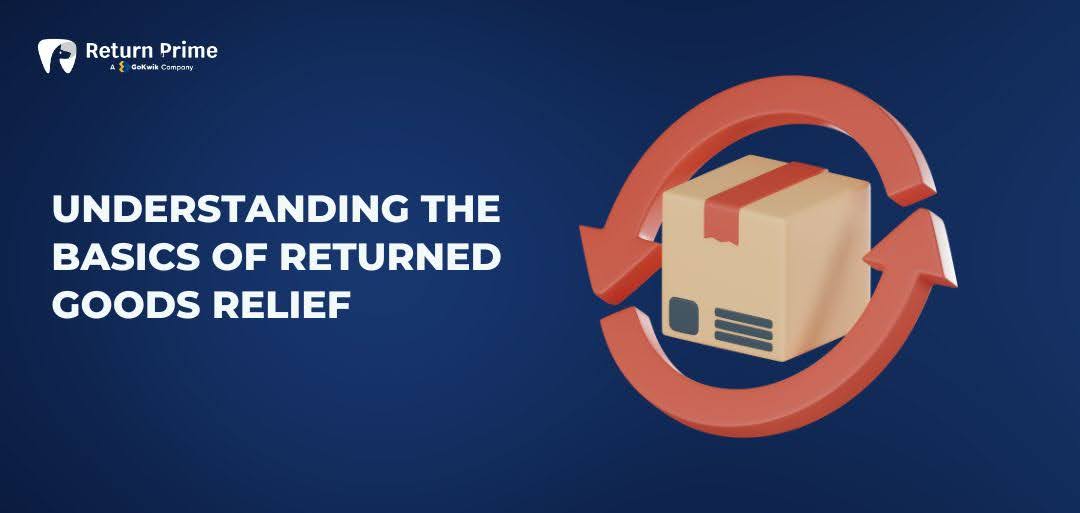Understanding Reverse Logistics: Importance, Benefits, and Best Practices


The UK’s reverse logistics market is on the brink of a significant expansion, with a projected CAGR of 6.12% by 2027. This upward trend points to a bright future for this dynamic sector, sparking optimism and excitement among business owners and e-commerce managers.
This future growth underscores the increasing importance of efficient reverse logistics strategies for businesses of all sizes.
Reverse logistics is not just a beneficial concept. It's a turning point for managing returns and recovering value in your business. Let’s explore its definition and understand why it’s crucial, equipping you with the knowledge you need to make informed decisions.
What is Reverse Logistics?
Reverse logistics involves moving products from customers back to your business. It’s a vital section of supply chain management that handles returns, recycling, and disposal. Excelling at reverse logistics can improve customer satisfaction by providing hassle-free return processes, recovering lost revenue, and reducing environmental impact.
If you run an e-commerce store on Shopify, effective reverse logistics ensures consistent return management and drives revenue through upsells and exchanges.
When Should You Implement Reverse Logistics?
Reverse logistics should be a key consideration for businesses seeking to improve customer satisfaction, enhance sustainability, and gain a competitive edge. Here’s a breakdown of when you should use reverse logistics:
- When customer returns are frequent: If your company experiences a high volume of product returns, implementing efficient reverse logistics processes is crucial to minimize costs and improve customer satisfaction.
- When product recalls are necessary: A reliable reverse logistics system is essential for quickly and effectively retrieving affected products from the market when safety hazards or quality issues arise.
- To improve sustainability: If your company aims to reduce its environmental impact, reverse logistics plays a key role in recycling, reusing products, minimizing waste, and conserving resources.
- To enhance customer service: By providing seamless and efficient return processes, you can improve customer satisfaction and build brand loyalty.
- To gain a competitive advantage: Offering convenient and eco-friendly return options can differentiate your company from competitors and attract environmentally conscious customers.
These points emphasize the strategic benefits of utilizing reverse logistics proactively. Let’s explore the different types of reverse logistics and how they apply to your business.
Types of Reverse Logistics
Reverse logistics isn’t just about handling returns. It covers several key processes that can boost efficiency and sustainability in your operations. Let’s break it down.
- Returns Management: Effectively handling returns is crucial for keeping customers happy. This process involves inspecting returned products, restocking, offering exchanges, or managing disposal.
- Remanufacturing and Refurbishment: Repairing and reconditioning products give them a second life, helping you recover revenue. This can be a catalyst if you sell electronics or other high-value items.
- End-of-Life Product Management: At the end of their lifecycle, products need recycling or responsible disposal. These efforts reduce waste and show your commitment to sustainability.
- Packaging Management: Reusing and recycling packaging materials saves costs and reduces waste. Plus, it aligns with eco-friendly goals that customers value.
- Logistics for Second-Hand Products: Second-hand sales are growing in popularity. Reverse logistics, particularly Green Reverse Logistics, can significantly support this by enabling you to resell pre-owned products and tap into new revenue streams. This includes efficient handling of returns from online sales, rental returns, and other channels.
Turn refunds into store credits with Return Prime’s Wonder Promotions to keep customers loyal and incentivize future purchases. Start retaining more revenue today.
Now that we’ve covered the types of reverse logistics, we can compare them to traditional logistics. Let’s take a closer look.
Traditional vs. Reverse Logistics

Traditional logistics and reverse logistics are similar, but their objectives and processes differ. Understanding these differences can help you optimize both.


Now that you know how these processes differ, let’s examine the five Rs, the core principles of reverse logistics.
The Five Rs of Reverse Logistics
Understanding the Five Rs can make your reverse logistics strategy more effective and customer-focused. Here’s what they mean for you.
- Returns: Returns can occur for various reasons, such as defective products, incorrect orders, or customer dissatisfaction. A clear, efficient process can turn this into an opportunity to build trust.
- Recalls: If a product is defective or unsafe. A solid recall strategy ensures minimal disruption.
- Repairs: Fixing a product instead of discarding it saves money and shows your commitment to reducing waste. This is especially valuable for high-ticket items.
- Recycling: Breaking down products to reuse materials contributes to sustainability goals and reduces your carbon footprint.
- Repackaging: Refurbished items often need to be repackaged for resale. When done right, this can maintain product quality and reassure your customers.
Turn returns into exchanges with Wonder Smart Exchange and retain revenue while improving customer satisfaction. Encourage exchanges over refunds with Return Prime’s smart algorithms.
Understanding these core elements presents the stage for exploring logistic reverse logistics's benefits. Let’s examine how it can impact your business.
The Benefits of Reverse Logistics

Reverse logistics offers many benefits, significantly impacting your bottom line and customer loyalty. Here's how it can transform your business and instill confidence in its potential.
- Reduced Costs: Refining the returns process can significantly reduce costs associated with handling returns, repairs, and disposal.
- Brand Reputation: Effective reverse logistics demonstrates a commitment to customer satisfaction and environmental responsibility. This enhances your brand's reputation and sets you apart from competitors. Customers are increasingly drawn to brands that prioritize sustainability and ethical practices.
- Data-Driven Insights: Analyzing return data provides valuable insights into product quality, customer preferences, and market trends. This information can improve product design, marketing strategies, and overall business operations.
- Product Improvement: Analyzing return reasons helps identify product defects and areas for improvement. This allows for proactive product development and reduces the likelihood of future returns, ultimately enhancing customer satisfaction and reducing costs.
- Competitive Advantage: In today's competitive market, efficient reverse logistics can provide a significant competitive advantage. Businesses can attract and retain loyal customers by offering a superior returns experience and demonstrating a commitment to sustainability.
- Compliance with Regulations: Many industries have specific product returns, recycling, and disposal regulations. Effective reverse logistics ensures compliance with these regulations, avoiding costly fines and legal issues.
- Enhanced Customer Satisfaction: Customers appreciate a hassle-free return experience. A clear and convenient returns policy builds trust and loyalty, encouraging repeat business. Satisfied customers are more likely to recommend your store to others, expanding your customer base.
Return Prime’s return and exchange policies allow you to tailor the return process to fit brand identity and customer needs.
While these benefits are impressive, implementing reverse logistics isn’t without challenges. Let’s address the common hurdles next.
Challenges in Implementing Reverse Logistics
Like any process, reverse logistics comes with its set of challenges. Identifying these issues is the first step to conquering them and optimizing your operations.
- Unpredictable Return Volumes: Fluctuating returns due to seasons, promotions, and customer behavior make resource allocation challenging.
- Time-Consuming Inspections: Assessing return quality requires careful inspection, slowing down processing.
- High Processing Costs: Transportation, inspection, sorting, and disposal significantly increase operational costs.
- Customer Expectations and Fraud: Managing customer expectations and dealing with unauthorized returns can be complex.
- Inventory Challenges: Integrating returns into inventory, tracking them, and managing surplus stock are significant hurdles.
- Data Management Challenges: Collecting, analyzing, and utilizing return data effectively is crucial but difficult.
- Environmental Impact: Minimizing the ecological impact of reverse logistics operations is crucial.
Now that you understand the challenges let’s consider the strategies to optimize your reverse logistics processes.
7 Strategies to Optimize Return Logistics
Here are the seven proven strategies to turn returns from a liability into a valuable asset.
- Make returns easy for customers: Keep your return policy simple and easy to find. Offer convenient options like online portals for initiating returns.
- Use technology to your advantage: Automate tasks like generating return labels and tracking returns with software. Analyze return data to understand trends and find ways to improve.
Return Prime’s Wonder Bot Automation can optimize workflows, minimize manual labor, and reduce transportation costs.
- Optimize transportation costs: Choose shipping carriers that offer reliable and affordable return options. Group smaller returns together to save on shipping. Consider partnering with companies that specialize in handling returns.
- Improve product quality: Reduce the number of returns by improving product quality and minimizing defects. Provide clear and accurate product descriptions to help customers make informed decisions.
- Focus on customer satisfaction: Provide excellent customer service throughout the return process. Keep customers informed about the status of their returns.
Return Prime offers automated notifications for customers to initiate returns, track statuses, and choose flexible options like exchanges or store credit.
- Use data to make better decisions: Analyze return data to understand customer behavior and identify areas for improvement. Use this information to make better decisions about your products and processes.
- Prevent returns whenever possible: Proactively address customer concerns to prevent unnecessary returns. Ensure accurate order fulfillment to minimize returns due to incorrect or missing items.
Implementing these strategies can improve your reverse logistics process, reduce costs, increase customer satisfaction, and build a stronger brand.
Let’s discover how Return Prime efficiently handles Reverse logistics.
Rationalizing Reverse Logistics with Return Prime
Return Prime, a Gokwik company, simplifies Shopify stores' complex reverse logistics process. Centralizing all return, exchange, and refund operations within a single platform streamlines the entire journey, from customer initiation to final resolution.
Here's how Return Prime helps:
- Wonder Bot Automation: Automates return label generation, refunds, and exchanges, saving time and minimizing errors.
- Automated notifications: Return Prime offers an intuitive portal for customers to initiate returns, track statuses, and choose flexible options like exchanges or store credit.
- Wonder Promotions: Analyzes return data to identify patterns, improve product offerings, and prevent future returns.
- Wonder Smart Exchange: Encourages exchanges over refunds and promotes upselling during the return process to retain revenue.
- Design return and exchange policies: Tailors the return process to fit brand identity and customer needs.
Using these features, Return Prime empowers 10K global businesses to efficiently manage the reverse logistics process, reduce operational costs, and ultimately enhance customer satisfaction.
Finally, let’s recap why reverse logistics is critical and how it can elevate your business.
Conclusion
Reverse logistics is a critical part of modern supply chain management, enabling businesses to turn challenges like returns and recycling into opportunities for growth. By streamlining these processes, companies can reduce costs, improve customer satisfaction, and contribute to sustainability goals. A well-planned reverse logistics strategy helps businesses create a more efficient operation while building customer trust and loyalty.
For e-commerce businesses, particularly those using platforms like Shopify, simplifying and organizing the returns process is essential to staying ahead. Solutions that help automate workflows, analyze return trends, and offer flexible customer options are becoming increasingly important in today’s competitive landscape.
Return Prime offers a solution designed to simplify the complexities of reverse logistics. With features such as automation, smart exchanges, and insightful data tracking, it helps businesses manage returns more effectively, improve customer experiences, and recover lost revenue.
Start optimizing your reverse logistics today. Visit Return Prime to learn how it can make a difference for your business. Book a demo now!








.svg)


.svg)

